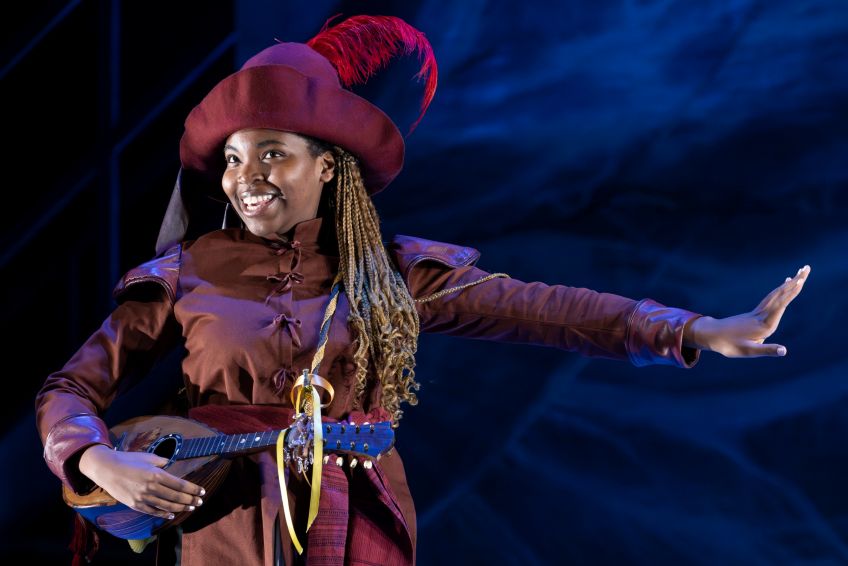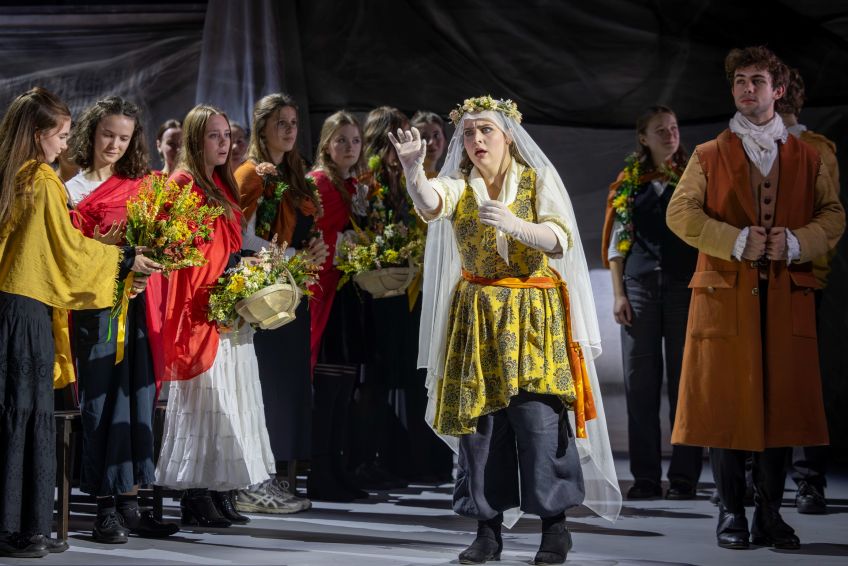In the creepy-crawly run-up to Hallowe’en this year, Opera North’s 2025/2026 season kicks off in characteristically innovative style with the musical mystery of Judith Weir’s nasty black spider in a battle of good versus evil. Handsomely staged, the 75-minute musical drama is performed by Opera North’s very splendid Youth Orchestra, Youth Company and Chorus plus two professional singers in key roles.
Commissioned as a short, opera-style work for younger people, Weir’s original version of the comic-horror tale, which she categorised as “somewhere between a video nasty and an Ealing comedy”, premiered in Canterbury Cathedral crypt in 1985 as The Black Spider. Quirkily, Opera North’s 2025 production is also a UK premiere since this time it performs The Mystery of The Black Spider, an English version of the Hamburg Version, Das Geheimnis der schwarzen Spinne. With revised orchestrations by Benjamin Gordon, this Hamburg version premiered in Germany in 2009 with Judith Weir attending. Another first is that this is the first opera by a female composer to appear on Opera North’s main stage, and written, into the bargain, by the first woman to be a Master of King’s Music (2014-2024). This Leeds version of the English version of the Hamburg version has gone down splendidly with both audiences and Dame Judith.

Fine set, costumes and lighting together fittingly evoke grey, Gothic, cloudy, misty gloom on two levels as cobwebby garments and gauzy mountain peaks conjure up a suitable atmosphere for the dark tale – or rather, for the two dark tales, since two different stories are linked here, alternating back and forth, in time-travel fashion, between Poland in the 1400s and in the 1970s. Each of the stories has a chilly horror, but melodrama, farce and comedy sit firmly at the forefront.
Weir’s main story is based on Jeremias Gotthelf’s Gothic novella of 1842, a tale of medieval villagers in Poland oppressed by ruthless Count Heinrich who forces them to haul an entire forest up to his mountain home just so he can have shade. Impossible, of course – until a mysterious Green Man offers to do the entire job in the blink of an eye just as long as one of the village maidens marries him. In spite of being about to wed Carl, Christina offers. But, oh-oh, she breaks her promise and weds Carl after all. Bad move! Now the devilish Green Man lets loose a vicious, deadly Black Spider to ravage, terrorise and kill as it runs riot in ways both horrifically deadly and comically ridiculous. After many deaths and much ado, the (invisible) spider is caught in a trumpet and sealed into the tomb of a recently deceased king. The plot’s second thread, based on actual 1980’s newspaper reports, concerns archaeologists, taken ill and/or mysteriously dying after opening this same King’s tomb, from which – ooer! – a black spider has emerged.
As the stories play out in episodic bursts, short, spoken, twentieth century scenes (whose hammers and chisels coordinate beautifully with the percussion) intersperse with longer medieval ones, involving music of many styles with elements of classical opera, panto, hymn-singing and folk-singing, all tailored for younger audiences and predominantly younger performers. Throughout, glorious instrumental treats, melodic and rhythmic, shine forth from every orchestral quarter – from two fine clarinets, two splendid trumpets, harp and a variety of percussion as a sturdy fullness of strings underpins the mood with uneasy discords, deep pacings, hoverings and up-and-down-the-scale tensions. Full chorus songs ring out most pleasingly from an ensemble of nigh on fifty, some of whom will pursue music for life and some of whom won’t, relishing roles as villagers who toil and sweat, drink, feast and hiccup or panic and fill with fear.

All-round eclectic, the piece ranges from a pedestrian simplicity of words as at a school play to brightly sparkling, opera-house purple patches. Injecting animated fun into a character both serious and comical is professional singer Pasquale Orchard as Christina, her protracted, opera-spoof death bringing laughter as she “arias” heartily from her death-bed – several times – before expiring, only to revive and skip off, bursting with health. Ross Ramgobin sings the tyrannical Count, dark and severe in Romanesque helmet and armour. His mock maniacal laugh makes the villain less seriously scary, though, which is, perhaps, a shame. Intense horror is not the predominant vibe of The Green Man, either, Daniel Wright gaining valuable experience as he takes on this prominent, green-clad role, accompanied by three, song-enhancing, gauzy-clad shadows, as well as also playing the hymn-singing priest. Akele Obiang as Christina’s cousin Caspa/Casper is a wonderfully jolly, charming presence in the vein of a carefree, lute-toting, strolling minstrel – or a Blue Peter presenter – full of wit and radiance.
The staging of bold, innovative, inspiring opera is one of Opera North’s foremost aims. Another equally determined aim is to take music, opera and creativity to as wide a swathe of the community as possible, broadening the range of audiences as well as performers. Opera North’s Simon Boccanegra is the recent winner of the 2025 SkyArts Award, with fingers crossed for a further award, while its production of Kurt Weill’s Love Life has been nominated for a prestigious International Opera Award in the new Musical Theatre category. But alongside all this professional excellence, Opera North regularly engages with three thousand schoolchildren a week in the wider community amongst other things. The huge company/family of young people involved in all aspects of The Mystery of The Black Spider demonstrates perfectly the scope and success of its endeavours in creating opportunities for many to enjoy the fun, hard work and polish involved in performing. “We Are the Future”, sang the younger choir pre-show, making the future look that little bit brighter just by being there, singing.
And the moral of the tale? Well, as the fleeing, flouncing priest rattily admits – no-one quite knows – but everyone certainly feels better for having been a part of it.
Eileen Caiger Gray




